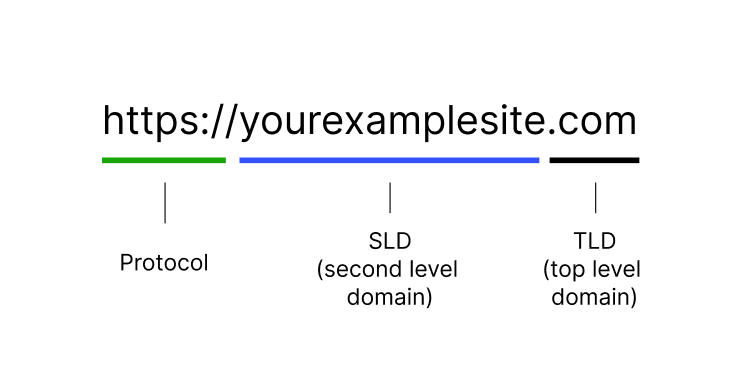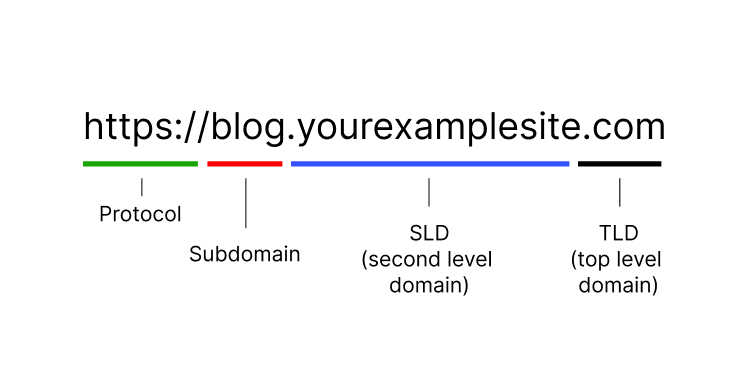- What Is a Root Domain?
- URL Structure
- What Are Subdomains?
- Top 4 Uses of Subdomains
- How to Create Separate Domains
- Do You Need Subdomains?
- Conclusion
What are subdomains you might ask. Subdomains refer to the portion of a domain name that precedes the main domain name and domain extension. They can assist in arranging the content of your website.
What Is a Root Domain?
A root domain is the main domain name of a website, without any subdomains. It is the base level of a website’s domain structure, and all subdomains and pages are part of the root domain. For example, in the URL “www.yourexamplesite.com,” “yourexamplesite.com” is the root domain.
The root domain is registered with a domain registrar and is unique to each website. It is an essential part of a website’s online identity, as it serves as the main address that users enter to access the site. Additionally, all other domain names associated with a website, such as subdomains, must be created under the root domain.
The Components of a Main Site URL Structure
Let’s take a look at the URL https://yourexamplesite.com as an example.
This URL has two parts:
- The protocol (https:) which is a set of rules that a browser follows to send a request to the server.
- The domain name (yourexamplesite.com) is the primary domain name for the website. A domain name comprises two parts:
- The top-level domain (TLD) which is the .com part or another domain extension, and
- The second-level domain (SLD), which is the name you buy from a domain registrar. In this case, the second-level domain is “yourexamplesite”.

What Are Subdomains?
Subdomains are part of the URL address of a website. The difference from the main site domain is that it contains an additional name before the SLD. For instance, if you want a helpdesk hosted on https://help.yourexamplesite.com, “help” would be the subdomain. These will share the same root domain.

In the following, we will talk about the uses of subdomains.
The Top 4 Uses of Subdomains
1. Content Organization
Subdomains are frequently utilized to divide a website into distinct sections. They can be used to categorize content into distinct areas or sections of the website. So each section can have its own name, with this they will work like a separate website.
Let me show some examples, for instance, a company might use one to separate its main website from its blog (blog.yourexamplesite.com) or its eCommerce store (store.yourexamplesite.com).
2. Localization
They can also be used to create localized versions of a website for different countries or regions.
For example, a business with a global presence might create subdomains for different languages or regions, creating separate sites such as en.yourexamplesite.com for English-speaking customers or fr.yourexamplesite.com for the French-speaking market. By adding a subdomain they can have separate sites under the same main domain name.
3. Separating services
Subdomains can be used to provide separate services for a website, such as a customer support portal or a forum. These services can be hosted on separate domains to keep them distinct from the main website.
4. Testing and Development
Subdomains can also be used for testing and development purposes. For instance, developers can create a new one to test new features or updates before implementing them on the main website.
Summarizing the Uses of Subdomains
Subdomains can be an incredibly useful tool for managing and organizing different aspects of a website. They offer a flexible and scalable way to divide content into distinct areas, allowing businesses to create a more organized and user-friendly website structure.
They can also help businesses tailor their content to specific audiences. By creating subdomains for different languages, regions, or services, companies can offer a more personalized user experience, which can be especially important for global or diverse audiences.
Furthermore, subdomains can provide a way to test and develop new features or updates without affecting the main website. This can be especially helpful for developers who need to make changes to a website without disrupting the user experience.
How to Create a Separate Subdomain?
To create a subdomain, it is necessary to first have a main domain. If you have not yet obtained a domain name, we have an article about domain names and prices.
After purchasing a domain, you also acquire the rights to create subdomains within it. Here are the general steps to follow when creating a new one:
- Choose a name for your subdomain and add it as a record in your DNS settings.
- Redirect the subdomain to the server where it will be hosted.
- It’s worth noting that the “www” in “www.yourexamplesite.com” is also a subdomain, as it points to yourexamplesite.com.
Fortunately, most hosting providers, like BlueHost offer user-friendly tools to make the process of creating subdomains simple and straightforward.
Should You Add a Subdomain or the Primary Domain is Enough?
If you’re unsure whether to publish a page under your “www” subdomain or a different, consider the primary goals of your website. Pages related to these goals should be placed under “www”, while other pages can be placed under a custom subdomain if they make up a substantial part of your site. However, if there are only a few pages, a separate domain may not be necessary.
For instance, if you have an online store with a blog section, you can use “www.yourexamplesite.com” for your store and “blog.yourexamplesite.com” for your blog. Conversely, if your main focus is blogging with a secondary focus on selling merchandise, use “www.yourexamplesite.com” for your blog and “store.yourexamplesite.com” for the e-commerce side.
By utilizing subdomains, you can create distinct sections of content and services without creating new domain names for each part. This approach can improve user experience by making it easier for visitors to find what they need in one place. Ultimately, if subdomains enhance your visitors’ experience, it’s a worthwhile step to take.
Conclusion
In conclusion, subdomains provide an excellent solution for organizing and managing a website’s different sections or functionalities.
With subdomains, businesses can offer their visitors a better user experience, tailor their content to specific audiences, and create a more flexible and scalable web presence.
Creating a subdomain is a relatively simple process that requires registering a main domain and entering a subdomain record.
By understanding the benefits of subdomains and their common uses, businesses can make informed decisions on how to structure their website’s content and services to better serve their visitors’ needs.
FAQ
A subdomain is a prefix to a domain name, indicating a separate section or category of a website. It is part of the main domain name and is separated by a dot (“.”).
Subdomains are useful for organizing different sections of a website, creating separate areas for different types of content, and improving user experience by making it easier for visitors to find what they need.
To create a subdomain, you must have a main domain name first.
Then, you can create a subdomain by adding a prefix to the main domain name and configuring the DNS settings to point to the appropriate server.
Yes, you can change it by modifying the DNS settings and updating any links or references to the old subdomain name.
However, it’s important to note that changing it can impact search engines and SEO (search engine optimization) and may require additional steps to maintain search engine rankings.
It’s important to ensure that each subdomain is properly optimized for search engines. This means creating high-quality content that is relevant to your target audience and using proper on-page SEO techniques, such as including relevant keywords in your titles, meta descriptions, and content.
It’s also important to ensure that your subdomains are not duplicating content from other parts of your website or other websites.
In summary, while subdomains can be a useful tool for improving your website’s SEO, it’s important to approach them strategically and ensure that each is properly optimized for search engines.
